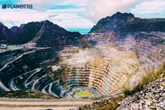Better Data At The Pace Of Production
Published by Jess Watts,
Editorial Assistant
Global Mining Review,

Underground mining presents a complex and unpredictable environment, where data collection is essential for safety, efficiency, and resource management. Yet, traditional methods of gathering geological and spatial data often have time constraints, challenges in getting trained personnel to collect the data, and difficulty getting the data in an acceptable position to make decisions promptly.
Many mining operations are dependent on paper mapping, photogrammetry, laser scanning, or tablet-based mapping for capturing geological features and mine geometry. However, these methods come with their own limitations. Data collection in the field can take anywhere from several minutes to over an hour per mine face, depending on conditions and the level of detail needed for mining. Additionally, the accuracy of the data is often hindered by environmental factors such as dust, low visibility, and physical obstructions. Integrating this data into mine planning systems can be a labour-intensive process that delays decision-making and disrupts production workflows.
While technology has significantly advanced the ability to capture highly detailed replicas of mine faces, it has also introduced new challenges. These include training personnel, handling large volumes of data, and ensuring seamless integration into existing workflows. As a result, there is a growing need for more efficient, automated solutions that can streamline data collection without compromising accuracy.
Bridging the gap: The need for real-time data solutions
In order to optimise underground mining operations, data collection tools must be designed to deliver reliable, high-quality information quickly and efficiently. An ideal system should integrate into production cycles without requiring extensive modifications to established workflows.
Key characteristics of such a system include:
- Ease of use: A data collection tool should be intuitive and require minimal specialised training.
- Speed: The ability to deliver accurate results in under 10 min. ensures that production is not hindered by lengthy processing or data collection times.
- Accuracy: High-resolution imaging and georeferenced data are essential for detailed geological mapping and planning.
- Durability: Equipment must withstand the harsh conditions of underground mining, including dust, moisture, and physical impacts.
Historically, one of the major obstacles in mining technology adoption has been the need for survey control and specialised placement. A truly effective solution would eliminate these additional steps, instead leveraging existing mine survey controls to streamline the process. Flexibility in data collection, such as the ability to capture information from multiple angles when obstructions are present, would greatly enhance usability in the field.
This is a preview of an article that was originally published in the May 2025 issue of Global Mining Review.
Subscribe to Global Mining Review for free to read this article in full and many more here.
Read the article online at: https://www.globalminingreview.com/mining/16052025/better-data-at-the-pace-of-production/
You might also like
The dual threat facing modern mining
Extreme weather is reshaping mining – driving floods, drought, and costly disruptions. Long-range environmental forecasting offers a path to safer operations, stronger infrastructure, and planning amid a rapidly intensifying water cycle.


